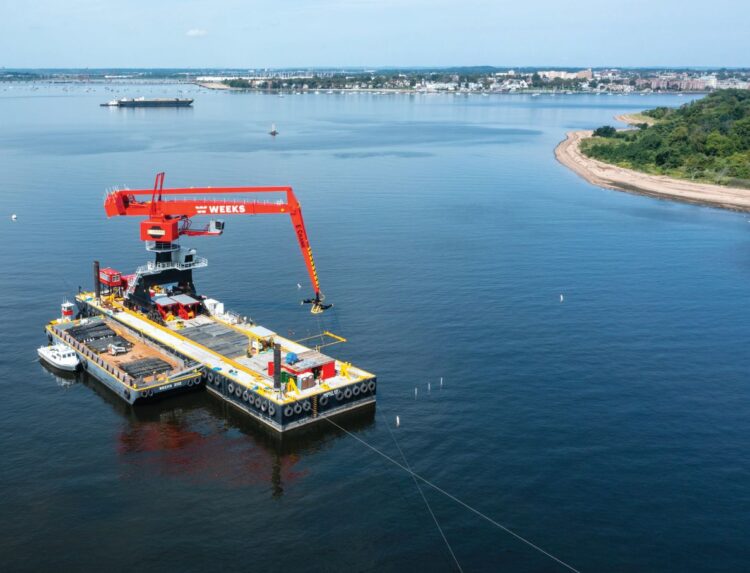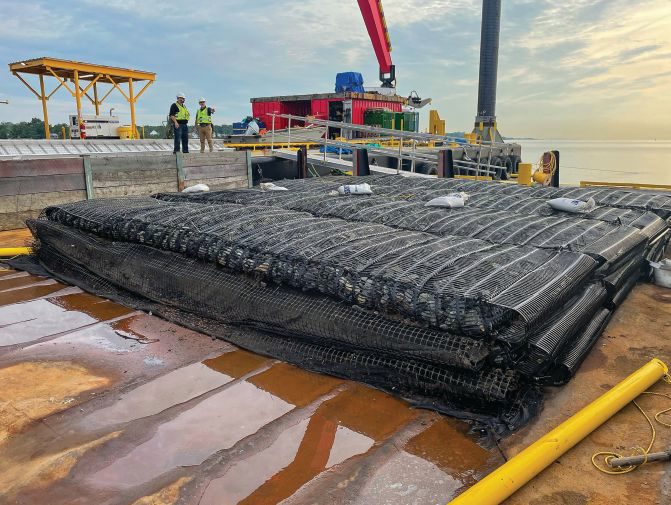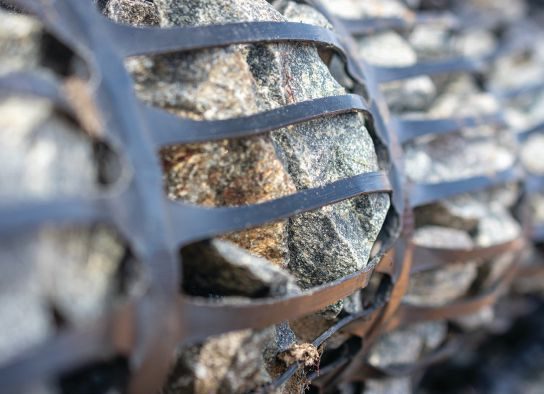Living Breakwaters Support Staten Island’s Shoreline Resilience

Triton Marine Mattresses were chosen to help build a system of living breakwaters in the Raritan Bay off the coast of Staten Island.
When it comes to the myriad problems resulting from climate change, it’s difficult to overstate the gravity of the problems facing coastal communities worldwide. Coastal erosion costs roughly $500 million per year for property loss in the United States. Scientists are confident sea levels will continue to rise through the end of this century and beyond. Where structures subject to scour are involved, the risk is especially grave, as disasters such as bridge collapses can ensue.
Now, savvy coastal stewards are embracing enhanced erosion protection: Living Breakwaters created from marine mattresses that provide a friendly environment for oyster habitation while mitigating the impact of rising waters and increasingly harsh waves.
The Problem with Hardening Living Shorelines
In the past, the proposed solutions to these problems focused on building higher, thicker and wider protective structures such as seawalls, groins, rip-rap, dikes, dams and revetments—also known as “gray infrastructure.” The operative idea has been to “harden” coastlines against the ravages of Mother Nature, but it has become apparent this approach doesn’t work. In fact, these rigid structures often cause worse damage, because they can interfere with natural water currents and prevent sand from naturally shifting along coastlines. They may protect the local area where they’re built, but may increase the damage and erosion in adjacent beaches and dunes by redirecting huge flows of water and debris their way.
But Mother Nature has evolved several strategies to tame the ferocity of storm winds and water and increase shoreline resilience. And today’s most forward-thinking scientists and engineers are attempting to follow her lead in devising their solutions to climate-change-related problems. The strategy is called “softening” or “green infrastructure.”
Staten Island’s Resilient Project for Shoreline Restoration
Whereas “hardening” coastline communities meant building structures against nature, softening builds with it by replicating the functions of natural storm-mitigation factors such as “oysters, tide pools, grasses, lots of colorful marine life … [which] were a big part of New York’s coastal-protection system,’’ said Karen Orff in The New Yorker Magazine. Orff is a landscape architect, MacArthur Fellowship recipient and designer of the Living Breakwaters Project currently being built in the waters off the coast of the hurricane-prone borough of Staten Island, N.Y., in lower New York Harbor.

A unique fabrication for the mattresses was developed to meet the site’s challenging geotechnical issues.
“They acted like breakwaters, absorbing wave energy and slowing the water before it hit the shore,” explained Orff. “We’ve spent the past 100 years dredging out everything for shipping and hardening the edges.”
Staten Island sits at the center of the New York Bight, a sharp bend in the shoreline between New Jersey and Long Island that funnels water directly onto its shore. Because of this, the borough is one of the East Coast’s most vulnerable areas to erosion, flooding and other hurricane damage. In 2012, Hurricane Sandy, one of the most destructive storms ever to hit the United States, swept through Staten Island, claiming 24 lives and causing nearly $20 billion in damage. The storm ripped down power lines, utility poles and trees. It caused major flooding in a number of low-lying shoreline communities across the borough.
In 2013, the Department of Housing and Urban Development sponsored a competition for designs to help communities increase resilience against the worst effects of future hurricanes. Orff entered and won the competition with her design for the Living Breakwaters. Her firm, SCAPE Landscape Architecture, now is the lead contractor on the $107 million project, which broke ground on Sept. 21, 2021. SCAPE is partnering with marine contractors COWI and Weeks Marine Inc. for the construction phase, which is scheduled to be completed in 2024.
Orff developed an ingenious system of Living Breakwaters that consists of discrete elements that work together to reduce storm damage as well as enhance plant and marine habitat in the Raritan Bay off the coast of Staten Island. Approximately 2,400 linear feet of near-shore “breakwaters,” or partially submerged rubble mound structures, will be built between 790 and 1,800 feet from shore, on a base constructed of approximately 1,100 12-inch Triton Marine Mattresses, covering approximately 120,000 square feet of seabed.
Like the naturally occurring marine breakwaters Orff referred to, these Living Breakwaters are designed to reduce erosion and storm damage by slowing down waves and dissipating their energy. Although it won’t be clear for years whether this strategy is a success, computer modeling of the site during the project’s development phase showed that had breakwaters existed in the area when Hurricane Sandy hit, wave heights would have been reduced by 4 feet.
In addition to dampening wave energy, the breakwater segments will—just like their nature-made counterparts—serve as habitat for oysters, lobsters and juvenile fish. Each breakwater consists of a stone core, a base layer made of Marine Mattresses to protect against scour, and outer layers of armor stones and ecologically enhanced concrete armor units.
The mattresses are composed of strong, flexible Tensar Geogrid filled with limestone. Tensar worked closely with subcontractors COWI and WSP in the initial design to develop a unique fabrication for the mattresses to meet the challenging geotechnical issues of the site such as irregular land contours, variable subgrades, continuous scour and generally harsh conditions.

Triton mattresses are composed of strong, flexible Tensar geogrid that resist all naturally occurring forms of chemical, biological and environmental degradation.
Another important goal of the Living Breakwaters project is an ambitious restoration of the 220,000 acres of oyster reef that once encircled New York Harbor. For this, it’s partnering with the Billion Oyster Project, a citizen science initiative working to grow a billion oysters in the bay by 2035. Massive oyster reef systems were once a natural defense against storm damage, softening the blow of large waves, reducing flooding and preventing erosion. And since one adult oyster can filter up to 50 gallons of water per day, they helped keep the water clean. And for hundreds of years, the reef provided sustenance and livelihood for the Lenape tribe who lived on the island as well as the European settlers who replaced them.

Triton Marine Mattresses go in as a discreet size and can be positioned using GPS to ensure correct installation.
Marine Mattresses are critical to the success of the oyster restoration, as their limestone filling will provide the substrate for growing the oysters. Oyster sprat, or larvae, incubated in repurposed and disinfected oyster shells from New York restaurants, will then be transported to the mattresses, where they will attach and grow to maturity.
The Marine Mattresses already have proved to be successful as oyster incubators. From 2008 to 2015, Dr. Earl Melancon, professor emeritus at Nicholls University, conducted a study of three shore-protection methods in Terrebonne County, La., an area suffering from severe erosion and habitat loss. He and his team compared Triton Marine Mattresses against a permeable matrix of interlocking concrete armor units and an artificial reef design made from steel and recycled oyster shells. Of the three methods tested, “the sloping Marine Mattresses gave an opportunity for oysters to colonize more readily, and that allowed for the creation of more reef structure,” Melancon said in an interview with Tensar. 
About Steve Williams
Steve Williams, P.E., is the Tensar industry manager for Marine & Ports; email: [email protected].


